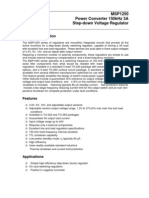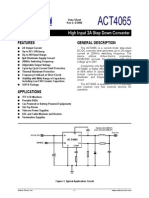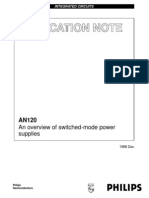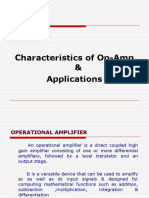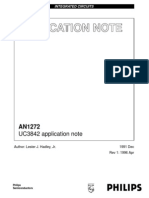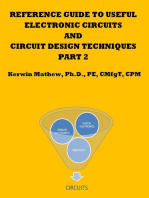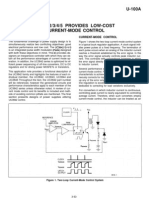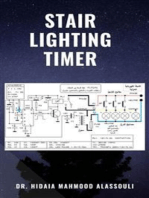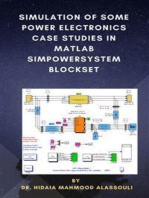78S40
78S40
Uploaded by
Pravin MevadaCopyright:
Available Formats
78S40
78S40
Uploaded by
Pravin MevadaCopyright
Available Formats
Share this document
Did you find this document useful?
Is this content inappropriate?
Copyright:
Available Formats
78S40
78S40
Uploaded by
Pravin MevadaCopyright:
Available Formats
Switching regulator 78S40
Issued March 1997
RS stock number 657-729
The 78S40 is a monolithic switching regulator IC con-
sisting of all the active building blocks necessary for
switching regulator systems. The device can be used
for step down, step up or inverting regulators as well as
for series pass regulators. It features wide supply volt-
age range, low standby power dissipation, high effi-
ciency and low drift. It is useful for any stand-alone, low
part-count switching system and works extremely well
in battery operated systems.
Absolute maximum ratings
Input voltage from V+ to V- ____________________40V
Input voltage from V+ op amp to V- _____________40V
Common mode input range (error amplifier
and op amp) _________________________0.3 to V+
Differential input voltage (Note 1)______________30V
Output short circuit duration (op amp) _____continuous
Current from V
REF
___________________________10mA
Voltage from switch collectors to GND___________40V
Voltage from switch emitters to GND____________40V
Voltage from switch collectors to emitter_________40V
Voltage from power diode to GND______________40V
Reverse power diode voltage__________________40V
Current through power switch_________________1.5A
Current through power diode__________________1.5a
Internal power dissipation (Note 2) _________1500mW
Storage temperature range_________65C to +150C
Operating temperature range__________0C to +70C
Lead temperature (soldering, 10s) __________+260C
Notes:
1. For supply voltages less than 30V, the absolute max-
imum voltage is equal to the supply voltage.
2. Rating applies to +25C. Above +25C ambient,
derate at 14mW/C.
Features
G Step-down, step-up or inverting switching regulator
G Output adjustable from 1.3 to 40V
G Peak currents to 1.5A without external transistors
G Low standby current drain
G 80dB line and load regulation
G High gain, high current, independent op-amp
G Pulse width modulation with no double pulsing.
232-2936
Dat a Sheet
Data Pack J
232-2936
2
Characteristics Conditions Min. Typ. Max. Units
General
Supply voltage 2.5 40 V
Supply current V
IN
= 5.0V 1.8 3.5 mA
(op amp disconnected) V
IN
= 40V 2.3 5.0 mA
Supply current op amp V
IN
= 5.0V
4.0 mA
V
IN
= 40V
5.5 mA
Reference section
Reference voltage I
REF
= 1.0mA (0<TA <70C) 1.180 1.245 1.310 V
Reference voltage temperature I
REF
= 1.0mA 100 ppm/C
coefficient
Reference voltage line regulation V
IN
= 3.0V to V
IN
= 40V, I
REF
= 1.0mA 0.04 0.2 mV/V
Reference voltage load regulation I
REF
= 1.0mA to I
REF
= 10mA 0.2 0.5 mV/mA
Oscillator section
Charging current V
IN
= 5.0V 20 50 A
Charging current V
IN
= 40V 20 70 A
Discharge current V
IN
= 5.0V 150 250 A
Discharge current V
IN
= 40V 150 350 A
Oscillator voltage swing 0.5 V
t
on
/t
off
6.0 s/s
Current limit section
Current limit sense voltage 250 350 mV
Output switch section
Output saturation voltage Q
2
I
SW
= 1.0A (Darlington configuration) 1.1 1.3 V
Output saturation voltage Q
1
I
SW
= 1.0A (Q
1
only) 0.45 0.7 V
Output transistor h
FE
I
C
= 1.0A, V
CE
= 5.0V 70
Output leakage current V
OUT
= 40V 10 nA
Power diode
Forward voltage drop I
D
= 1.0A 1.25 1.5 V
Diode leakage current V
D
= 40V 10 nA
Comparator
Input offset voltage V
CM
= V
REF
1.5 15 mV
Input bias current V
CM
= V
REF
35 200 nA
Input offset current V
CM
= V
REF
5.0 75 nA
Common mode voltage range 0 V
+
2 V
Power supply rejection ratio V
IN
= 3.0V to 40V 70 96 dB
Output operational amplifier
Input offset voltage V
CM
= 2.5V 4.0 15 mV
Input bias current V
CM
= 2.5V 30 200 nA
Input offset current V
CM
= 2.5V 5.0 75 nA
Voltage gain + R
L
= 2.0k to GND; V
O
= 1.0 to 2.5V 25k 250k V/V
Voltage gain - R
L
= 2.0k to V
+
op amp; V
O
= 1.0 to 2.5V 25k 250k V/V
Common mode voltage range 0 V
+
2 V
Common mode rejection ratio V
CM
= 0 to 3.0V 76 100 dB
Power supply rejection ratio V
+
op amp = 3.0 to 40V 76 100 dB
Output source current 75 150 mA
Output sink current 10 35 mA
Slew rate 0.6 V/s
Output voltage LOW I
L
= -5.0mA 1.0 V
Output voltage HIGH I
L
= 50mA V
+
op amp V
-3.0V
Electrical characteristics V
IN
= 5.0V, V
op amp
= 5.0V, T
A
= +25C unless otherwise specified.
232-2936
3
Typical performance curves
Principle of operation
A dc power supply is usually regulated by some type
of feedback circuit that senses any change in the dc
output and develops a control signal to compensate for
this change. This feedback maintains an essentially
constant output.
In a monolithic regulator, the output voltage is sampled
and a high-gain differential amplifier compares a por-
tion of this voltage with a reference voltage. The output
of the amplifier is then used to modulate the control
element, a transistor, by varying its operating
point within the linear region or between the two
operating extremes, the cut-off and saturation.
When the pass transistor is operated at a point
between cut-off and saturation, the regulator
circuit is referred to as a linear voltage regulator.
When the pass transistor is operated only at
Figure 1 C
T
as a function of t
off
Figure 2 V
REF
as a function of T
J
Figure 4 V
Sense
as a function of V
IN
Figure 3 I
discharge
as a function of V
IN
cut-off or at saturation, the circuit is referred to as a
switching regulator.
The advantage of the switching regulator over the
more conventional linear regulator is greater
efficiency, since cut-off and saturation modes are the
two most efficient modes of operation. In the cut-off
mode, there is a large voltage across the transistor
but little current through it; in the saturation mode,
the transistor has little voltage across it but
carries a large amount of current. In either case,
little power is wasted, most of the input power is
transferred to the output, and efficiency is
high. Regulation is achieved by varying the duty
cycle that controls the average current transferred to
the load. As long as this average current is equal to the
current required by the load, regulation is maintained.
Figure 5 Regulator system block diagrams
232-2936
4
Architecture
Each of the fundamental operating modes is built from
the same set of function blocks (Figure 6). Additional
functions are required for control and protection, but
again, these functional blocks are common to each of
the operational modes. The different modes are
obtained by proper arrangement of these basic blocks.
For maximum design flexibility and minimum external
part count, the RS 78S40 was designed to include all of
the fundamental building blocks in an uncommitted
arrangement. This provides for a simple, cost-effective
design of any switching regulator mode.
The functional blocks of the regulator, illustrated in
Figure 6, are:
- Current-controlled oscillator
- Temperature-compensated current-limiting circuit
- Temperature-compensated voltage reference
- High-gain differential comparator
- Power switching circuit
- High-gain amplifier
The current-controlled oscillator generates the gating
signals used to control the on/off condition of the
transistor power switch. The oscillator frequency is set
by a single external capacitor and may be varied over
a range of 100Hz to 100kHz. Most applications require
an oscillator frequency from 200 to 30kHz. The
oscillator duty cycle (t
on
/t
off
) is internally fixed at 6:1, but
may be modified by the current-limiting circuit.
The temperature-compensated, current-limiting cir-
cuitry senses the switching transistor current across an
external resistor and may modify the oscillator on-time,
which in turn limits the peak current. This provides
protection for the switching transistor and power diode.
The nominal activation voltage is 300mV, and the peak
current can be programmed by a single resistor R
SC
.
A 1.25V temperature-compensated, band-gap voltage
source provides a stable reference to which the sam-
pled portion of the output is compared. The reference
is capable of providing up to 10mA of current without
an external pass transistor.
A high-gain differential comparator with a common
mode input range extending from ground to 1.5V less
than V
CC
is used to inhibit the basic gating signal
generated by the oscillator turning on the transistor
switch when the output voltage is too high.
The transistor switch, in a Darlington configuration with
the collectors and emitter brought out externally for
maximum design flexibility, is capable of handling up
to 1.5A peak current up to 40V collector-emitter volt-
age, and switching times that are normally 300-500 ns.
Although not required by the basic operating modes,
an independent operational amplifier has been
included to increase flexibility. The characteristics of
this amplifier are similar to the 741, except that a power
output stage has been provided, capable of sourcing up
Figure 6 Function blocks
to 150mA and sinking 35mA. The input has also been
modified to include ground as part of the common-
mode range. This amplifier may be connected to
provide series pass regulation or a second output
voltage, or configured to provide special functions for
some of the more advanced applications.
Operation of the comparator, operational amplifier,
and reference regulator are essentially identical to
individual integrated circuits performing these same
functions. However, some precautions should be noted
in the case of the on-chip diode. Because of the fact that
the integrated circuit substrate is normally at ground
potential, the cathode of diode must not be operated at
negative voltage; this precludes its use in step down
and inverting configurations. The internal construction
of the diode also results in a flow of current from the
anode to the substrate amounting to approximately
10% of the normal anode/cathode current. Because of
the usual high voltage between anode and ground,
dissipation limits the diode's usefulness in step-up
applications. The diode is useful as reverse protection
for the switch transistor and is shown connected in
manner in the accompanying drawings.
Where applications specify an external Schottky diode
(RSstock no. 262-466) the use of a silicon fast recovery
diode may be considered as a more cost effective
alternative. In some applications conventional silicon
diodes such as 1N4001 or 1N5401 etc. may be substi-
tuted although some loss of efficiency will be encoun-
tered.
The switching regulator can be operated over a wide
range of power conditions, from battery power to
high-voltage, high-current supplies. Low voltage
operation down to 2.4V and low standby current, less
than 2.5mA at 5V, make it ideal for battery-powered
Besides high efficiency operation, another advantage
of the switching regulator is increased application
flexibility offered by output voltages that are less than,
greater than, or of opposite polarity to the input
voltage.
Table 1 lists the design formulae used to derive the
values of the external components required for specific
outputs in the three modes of operation. Design
examples for step down, step up and inversion
operation are given on pages 5-8.
t
on
+ 1 =
t
on
+ t
off
t
off
t
off
t
off
=
t
on
+ t
off
=
200
microseconds
t
on
+ 1 1.30
t
off
t
off
= 154 microseconds
t
on
max = 46 microseconds
Note that the variable of interest is t
on
, the switch con-
duction time, which is the only variable under control of
the RS78S40.
The maximum value of t
on
is important because it allows
us to set the current limit to the appropriate level and to
select inductors with adequate peak current ratings.
The required timing capacitor value may now be
determined by using the minimum oscillator charging
current and the typical value for oscillator voltage
swing:
C
T
= (I
ch
)
t
=
20 10
-6
t
on
= (4 10
-5
) t
on
v
.5
C
T
= (4 10
-5
) (46 10
-6
)
C
T
= 1800pF
232-2936
5
Table 1 RS78S40 Design formulae
Characteristic Step down Step up Inverting
t
on
V
OUT
+ V
D
V
OUT
+ V
D
- V
IN
|V
OUT
| + V
D
t
off
V
IN
- V
SAT
- V
OUT
V
IN
- V
SAT
V
IN
- V
SAT
(t
on
+ t
off
)
(max.)
1 1 1
f
min.
f
min.
f
min.
C
T
4 10
-5
t
on
4 10
-5
t
on
4 10
-5
t
on
I
pk
2 I
OUT (max.)
2 I
OUT (max.)
t
on
+ t
off
2 I
OUT (max.)
t
on
+ t
off
t
off
t
off
L
(min.)
V
IN
- V
SAT
- V
OUT
t
on (max.)
V
IN
- V
SAT
t
on (max.)
V
IN
- V
SAT
t
on (max.)
I
pk
I
pk
I
pk
R
SC
0.33/I
pk
0.33/I
pk
0.33/I
pk
C
O
I
pk
(t
on
t
off
)
I
out
t
on
I
out
t
on
8 V
RIPPLE
V
RIPPLE
V
RIPPLE
( (
(
(((
Note:
V
SAT
- Saturation voltage of the switching element V
D
- Forward voltage of the flyback diode.
Design example - Step down regulator
Given the conditions: V
in
= 25V, V
out
= 5V, I
out
(max.) =
.5A, V
ripple
= 1%, we can design a step-down switching
regulator as depicted schematically in Figure 8.
First, determine the ratio of switch conduction verses
diode conduction times:
t
on :
t
off
t
on
=
V
out
+ V
D
(from table 1)
t
off
V
in
- Vsat - V
out
=
5 + 0.7
=
5.7
=.30
25 - 1.1 - 5 18.9
Now, we add the requirement that in the continuous
conduction mode (coil current never goes to zero) we
want the minimum frequency to be above the audio
range:
f
min.
5kHz
therefore,
1
5000 sec-1
t
on
+ t
off
or (t
on
+ t
off
)
max
= 200 sec
Algebraic manipulation of the previously obtained
value of t
on
/t
off
will give us toff as a function of (t
off
+ t
on
)
and (t
on
/t
off
) which have been determined.
(
(
)
)
Of course, the typical charging current is higher than
20 microamps, so the typical operating frequency will
be greater than 5kHz.
232-2936
6
The minimum inductance value may now be obtained
by reference to the maximum on time and the desired
value of maximum load current.
I
peak
= 2 I
out (max.)
= (2) (.5A)
= 1.0A
L
(min.)
= (V
in
- V
sat
- V
out
) t
on
(max.)
I
peak
L
(min.)
= (18.9)
46 10
-6
1.0
L
(min.)
= 869 H
This minimum value of inductance was determined by
assuming the onset of continuous conduction operation
at the maximum value of load current for a minimum
charge current oscillator. As mentioned previously,
actual operating frequencies will typically be higher,
resulting in current waveforms more like Figure 7c at
full load. Larger than minimum values of inductance
reduce the value of load current at which continuous
conduction occurs as well as effect a reduction in the
peak to average switch current.
For this design, then, let's use an inductance value well
above the minimum; say 1500 micro Henries.
The reduced peak to average values of switch current
allow us to set the current limit threshold at two times
the maximum load current or 1.0A
R
sc
=
.33V
= .33
1.0A
The inductor must be specified to allow non-saturated
operation up to this peak current of 1.0 Amperes.
The actual output voltage waveform in Figures 7a, b, c
is extremely complex. An RMS value would be very
Figure 8 Step-down voltage regulator
Figure 7 Step-down regulator waveforms
difficult to obtain analytically because of the presence
of partial cycles. An approximation of the peak-to-peak
ripple can be obtained from the formula:
V
p-p
= (I
peak
) (t
on
+ (t
off
)
8C
O
For 1% ripple (peak to peak) on the 5 volt output:
C
O
= (1.0) (200 10
-6
)
(8) (.05)
C
O
= 500F
232-2936
7
Design example - step-up regulator
V
in
= 12V, V
out
= 28V, I
out
= 0.1A
V
ripple
= 1%
t
on
=
V
out
+ V
d
- V
in
=
28 + 0.7 - 12
t
off
V
in
- V
sat
12 - 0.5
=
15.3
= 1.33
11.5
choose: f
min.
= 10kHz
(t
on
+ t
off
)
(max.) =
1
= 100 sec
f
min.
t
off
=
t
on
+ t
off
=
100
= 43 sec
(max.)
t
on
+ 1 2.33
t
off
t
on
= 1.33 t
off
= 57 sec
(max.)
C
T
= (40 x 10
-6
) t
on
= 2283 pf.
I
peak
= 2 I
out(max.)
t
on
+ t
off
t
off
I
peak
= (2) (0.1)
(100)
= 0.46A
(93)
L
(min.)
=
V
in
- V
sat
t
on(max.)
=
12 - 0.5
(57 x 10
-6
)
I
peak
0.27
= 2.43 mH
R
SC
=
0.33 = 0.33
= 0.6 ohms
(1.2) I
peak
(1.2) I
peak
C
O
I
out
G ton
V
ripple
=
0.1
57 x 10
-6
0.28
= 20 F
Figure 9 Set-up voltage regulator
Design example - inverting regulator
A schematic of the basic inverting regulator is shown in
Figure 10.
Conditions
V
IN
= 12V I
out (max.)
= 500mA
V
OUT
= -15V V
RIPPLE
1% (peak to peak)
Calculations
An external PNP switching transistor is necessary for
the inverting regulator configuration because of polar-
ity limitations.
t
on
=
V
out
+ V
d
=
15 + 0.7
= 1.365
t
off
V
in
- V
sat
12 - 0.5
Let f
min.
= 8kHz
(t
on
+ t
off
)
(max.)
=
1
= 125 s
f
min.
t
off
=
t
on
+ t
off
=
125
=
125
=52.85s
t
on
+ 1
1.365 + 1 2.365
t
off
t
on
= 72.15s
C
T
= (4 x 10
-5
) t
on
= 2886 pF
make C
T
= 2700pF (2n7).
I
peak
= 2 x I
out(max.)
t
on
+ t
off
t
off
= (2 x 0.5)
125
= 2.365A
52.85
L
(min.)
=
V
in
- V
sat
t
on(max.)
=
12 - 0.5
72.15 10
-6
I
peak
2.365
= 350H
( )
232-2936
8
Figure 10 Inverting regulator
R
SC
=
0.33
=
0.33
= 0.12 ohms
(1.2) I
peak
1.2 x 2.365
C
O
=
I
out
t
on
V
ripple
=
0.5
x 72.15 10
-6
0.15
= 240F
Make C
O
= 220F
The sampling network, R
1
and R
2
, can easily be calcu-
lated. Assuming the sampling network current I
S
is
1mA:
R
1
=
V
REF
1.3k
I
S
R
2
=-V
OUT
= 15k
I
S
Set R
1
= 1.3k and use a 20k pot for R
2
so that output
voltage can be adjusted. R
5
should be 5 to protect
V
REF
, limiting I
S
to 2.6mA.
This application requires an external diode and transis-
tor since the substrate of the regulator is referenced to
ground and a negative voltage is present on the output.
The external diode and transistor prevent the substrate
diodes from a forward-biased condition.
R
3
is provided for quick turn-off of the external transis-
tor and is usually in the range of 100 to 300. R
4
can
be calculated as follows:
R
4
= V
IN
- V
SAT
- V
T
- V
BE
I
pk
/
where
V
T
= threshold voltage = 300mV
V
BE
= base emitter drop across the external transistor
=
1
/4 hFE of the external transistor
If the 2N5876 is used, the value for R
4
is:
R
4
=
12 -0.4 -0.3 -2.5
39
(2.34/10)
Again, capacitors can be placed at the input to reduce
transients.
Pulse width modulation
An alternative to the previously described mode of
operation is the configuration shown in Figure 12. In
this circuit the RS78S40 operates as a pulse-width mod-
ulator in which the duty cycle of the constant frequency
switching waveform is varied to control the output volt-
age. The oscillator ramp voltage appearing at pin 12
(C
T
) is fed to the non-inverting comparator input. The
output voltage is attenuated and subtracted from the
reference voltage in the on-chip operational amplifier
and the resulting error signal is fed to the inverting
input of the comparator.
The intersection of the ramp voltage on the non-invert-
ing output of the comparator with the error voltage on
the inverting input, modulates the turn-on point of the
output switch transistor during the positive-going ramp
of the oscillator. Turn-off, as always, takes place at the
onset of the negative-going oscillator ramp.
Because of the fast response of the pulse width modula-
tor to variations in output voltage, increased attention
must be paid to loop stability.
The pulse-width modulator, shown in Figure 12 uses a
simple, dominant pole technique to provide stable
operation with relatively slow response time.
Figure 11 Pulse width modulation waveforms
Figure 12 Pulse width modulation
232-2936
9
Additional circuits
Constant output voltage regulator
A useful variation is the use of the universal regulator to
provide a constant output for voltage inputs that are
both higher and lower than the output, (Figure 13). In
this case, 12V at 100mA is provided at the output for
input voltages over a 4V to 24V range. This is achieved
by using a step-up mode similar to the version shown
in Figure 9 to provide a 15V output and then using the
internal op amp as a series-pass regulator to reduce
the output to 12V. When the input voltage exceeds 16V,
the step-up regulator circuit follows the input at
approximately the input voltage minus 1V, but the
series-pass output remains constant at 12V. The op
amp exhibits excellent noise rejection, so output ripple
is virtually non-existent at the 12V output. Regulator
efficiency is about 50% for the upper and lower limits of
the input range (4V and 24V) and increases to a maxi-
mum of about 75% for intermediate voltages.
High current step-down regulator
Another variation involves the addition of an external
pnp transistor and an external catch diode to the step-
down regulator, (Figure 14). The transistor (Q
3
)
increases output current capability by a factor of 4 and
also improves switching efficiency because the switch-
ing voltage drops from 1.6V to 0.4V. The npn
Darlington pair switch is connected to provide the base
drive for Q
3
, with a 270 resistor limiting the base
drive to 100mA. A peak input current of 4A (plus the
80mA typ base drive) with an input voltage of 30V pro-
vides a 5V, 2A output.
In this case the off-time/on-time ratio is about 4.6:1 with
the off-time at 160s and on-time at 38s. Output
capacitance of 1000F keeps output ripple to within
100mV. The external diode (D
2
) is required to handle
the 4A switching current.
Dual tracking regulator
Figure 15 illustrates a dual-tracking regulator that pro-
vides both +15V and -15V outputs from a single +20V
input. The negative output voltage is generated with an
inverter circuit similar to the circuit of Figure 10, but the
op amp is connected in a unity gain configuration with
its output divided down and compared to the 1.25V
reference voltage. As shown, this regulator provides
15V at 100mA with 80% efficiency - 75% positive volt-
age, 85% negative voltage - with output ripple limited
to 30mV.
Figure 13 Constant output voltage regulator
over 4-24V input range
Figure 14 A 5V 2A step-down regulator
Figure 15 15V Dual tracking regulator
232-2936
Inductor design
The inductors required for the switching regulator cir-
cuits can be wound on the RM series of ferrite cores
(current catalogue).
The procedure for designing the inductor is as follows:
1. Calculate the value of inductance required from the
formula given for the type of circuit being designed.
2. Calculate LI
2
pk
in mJ.
3. Consult the RM series ferrite cores data sheet (see
latest catalogue or data sheet index for details) to
obtain a core which has an LI
2
sat
value equal to or
greater than LI
2
pk
LI
2
sat
LI
2
pk
To keep dc losses to a minimum, employ a core with a
large inductance factor, if possible, to reduce the
number of turns required for the inductance.
4. Calculate the number of turns required to obtain the
required inductance.
No. of turns = L
A
L
Where L is in nH
A
L
is the inductance factor
5. Select the largest diameter wire governed by the
maximum number of turns accommodated on the bob-
bin size employed.
As an example of the above procedure, consider the
step-up regulator circuit shown in Figure 9.
L = 2.5mH I
pk
= 0.46A
LI
2
pk
= 0.529mJ
From the RM series ferrite cores data sheet the smallest
core size which can be employed is the RM10.
(LI
2
sat
= 1.731 or 1.082mJ. To reduce dc losses, select
the RM10 core with the highest inductance factor ie.
400 (nH/turn
2)
.
Turns required = L
A
L
2.5 10
6
= 79.06 turns
400
Use 79 turns.
The maximum wire diameter which the RM10 core can
accommodate for 79 turns is 0.56 mm.
Hence wind 79 turns of 0.56mm dia. insulated copper
wire onto the bobbin of an RM10 core with an induc-
tance factor of 400nH/turns
2
.
Electro-magnetic interference (EMI)
Due to the wiring inductance in a circuit, rapid changes
in current generate voltage transients. These voltage
spikes are proportional to both the wiring inductance
and the rate at which the current changes:
V = L
di
dt
The energy of the voltage spike is proportional to the
wiring inductance and the square of the current:
E =
1
LI
2
2
Interference and voltage spiking are easier to filter if
the energy in the spikes is low and the components
predominantly high frequency.
The following precautions will reduce EMI:
- Keep loop inductance to a minimum by utilising
appropriate layout and interconnect geometry.
- Keep loop area as small as possible and lead lengths
short and, in step-down mode, return the input
capacitor directly to the diode to reduce EMI and
ground-loop noise.
The information provided in RStechnical literature is believed to be accurate and reliable; however, RS Components assumes no responsibility for inaccuracies
or omissions, or for the use of this information, and all use of such information shall be entirely at the users own risk.
No responsibility is assumed by RS Components for any infringements of patents or other rights of third parties which may result from its use.
Specifications shown in RS Components technical literature are subject to change without notice.
RS Components, PO Box 99, Corby, Northants, NN17 9RS Telephone: 01536 201234
An Electrocomponents Company RS Components 1997
You might also like
- LM108, LM117: Application Note 178 Applications For An Adjustable IC Power RegulatorNo ratings yetLM108, LM117: Application Note 178 Applications For An Adjustable IC Power Regulator7 pages
- 3.0A, 15V, Step-Down Switching Regulator: FeaturesNo ratings yet3.0A, 15V, Step-Down Switching Regulator: Features9 pages
- DC-DC Converter Tutorial: Application Note 2031No ratings yetDC-DC Converter Tutorial: Application Note 203110 pages
- Feature General Description: HT7A6005 Low Power, Wide Temperature Range General Purpose Current Mode PWM ControllerNo ratings yetFeature General Description: HT7A6005 Low Power, Wide Temperature Range General Purpose Current Mode PWM Controller11 pages
- Switching Power Supply Theory and ApplicationsNo ratings yetSwitching Power Supply Theory and Applications40 pages
- 100 VOLT 30 AMP H-Bridge PWM Motor Driver/Amplifier: M.S.Kennedy CorpNo ratings yet100 VOLT 30 AMP H-Bridge PWM Motor Driver/Amplifier: M.S.Kennedy Corp7 pages
- An Overview of Switched-Mode Power Supplies: Integrated CircuitsNo ratings yetAn Overview of Switched-Mode Power Supplies: Integrated Circuits6 pages
- Characteristics of Op-Amp & ApplicationsNo ratings yetCharacteristics of Op-Amp & Applications36 pages
- Switch Mode Power Supply and Switching RegulatorsNo ratings yetSwitch Mode Power Supply and Switching Regulators13 pages
- Ultra Fast Acting Electronic Circuit Breaker60% (5)Ultra Fast Acting Electronic Circuit Breaker55 pages
- Reference Guide To Useful Electronic Circuits And Circuit Design Techniques - Part 2From EverandReference Guide To Useful Electronic Circuits And Circuit Design Techniques - Part 2No ratings yet
- 2.5A Power Switching Regulator: DescriptionNo ratings yet2.5A Power Switching Regulator: Description16 pages
- Reference Guide To Useful Electronic Circuits And Circuit Design Techniques - Part 1From EverandReference Guide To Useful Electronic Circuits And Circuit Design Techniques - Part 12.5/5 (3)
- Simulation of Some Power Electronics Case Studies in Matlab Simpowersystem BlocksetFrom EverandSimulation of Some Power Electronics Case Studies in Matlab Simpowersystem BlocksetNo ratings yet
- Simulation of Some Power Electronics Case Studies in Matlab Simpowersystem BlocksetFrom EverandSimulation of Some Power Electronics Case Studies in Matlab Simpowersystem BlocksetNo ratings yet
- Some Power Electronics Case Studies Using Matlab Simpowersystem BlocksetFrom EverandSome Power Electronics Case Studies Using Matlab Simpowersystem BlocksetNo ratings yet
- STEM: Science, Technology, Engineering and Maths Principles Teachers Pack V10From EverandSTEM: Science, Technology, Engineering and Maths Principles Teachers Pack V10No ratings yet
- Multi Frequency On RGB Lighting LED Driver TechniqNo ratings yetMulti Frequency On RGB Lighting LED Driver Techniq7 pages
- How To Build A Fast Flexible Electric Vehicle EV Charging NetworkNo ratings yetHow To Build A Fast Flexible Electric Vehicle EV Charging Network4 pages
- Piud101 Piud108 Piud101 Piud108: Piqm310e Piqm310eNo ratings yetPiud101 Piud108 Piud101 Piud108: Piqm310e Piqm310e8 pages
- Panasonic WH-TD20B3E5 Domestic Hot Water SystemNo ratings yetPanasonic WH-TD20B3E5 Domestic Hot Water System18 pages
- LM1117-N/LM1117I 800ma Low-Dropout Linear Regulator: Features DescriptionNo ratings yetLM1117-N/LM1117I 800ma Low-Dropout Linear Regulator: Features Description33 pages
- Panasonic Lcd-2012-Et5series Troubleshooting Pravin MevadaNo ratings yetPanasonic Lcd-2012-Et5series Troubleshooting Pravin Mevada36 pages
- Yamaha RX-E810, RX-E410, NX-E800 Micro Combo100% (1)Yamaha RX-E810, RX-E410, NX-E800 Micro Combo57 pages
- Panasonic TX-28CK2P - Z-M3P Chassis CRT TV SMNo ratings yetPanasonic TX-28CK2P - Z-M3P Chassis CRT TV SM25 pages
- Video Signal Processor With Bitmap OSD, Dual HDMI TX, and Video EncoderNo ratings yetVideo Signal Processor With Bitmap OSD, Dual HDMI TX, and Video Encoder2 pages
- 400W Rms Hexfet Mosfet Symmetrical AmplifierNo ratings yet400W Rms Hexfet Mosfet Symmetrical Amplifier10 pages
- 1.5A Power Switching Regulator: DescriptionNo ratings yet1.5A Power Switching Regulator: Description16 pages
- Application Note 101 July 2005 Minimizing Switching Regulator Residue in Linear Regulator OutputsNo ratings yetApplication Note 101 July 2005 Minimizing Switching Regulator Residue in Linear Regulator Outputs12 pages
- Video Signal Processor With Bitmap OSD, Dual HDMI TX, and Video EncoderNo ratings yetVideo Signal Processor With Bitmap OSD, Dual HDMI TX, and Video Encoder2 pages
- BAV99 Small Signal Diode: Absolute Maximum RatingsNo ratings yetBAV99 Small Signal Diode: Absolute Maximum Ratings4 pages
- I C-Compatible Serial E Prom: General DescriptionNo ratings yetI C-Compatible Serial E Prom: General Description20 pages
- Experiment Biomedical Electronic OscillatorsNo ratings yetExperiment Biomedical Electronic Oscillators3 pages
- Some People Have Made Great Results Swapping The 6x5 For Ez81 (Using A Socket Converter or Something)No ratings yetSome People Have Made Great Results Swapping The 6x5 For Ez81 (Using A Socket Converter or Something)3 pages
- 030070502-Integrated Circuit and Application-QPNo ratings yet030070502-Integrated Circuit and Application-QP4 pages
- DM74LS244 Octal 3-STATE Buffer/Line Driver/Line Receiver: General Description FeaturesNo ratings yetDM74LS244 Octal 3-STATE Buffer/Line Driver/Line Receiver: General Description Features6 pages
- 5 Channels 2 Octave Graphic Equaliser by 4558 - Eleccircuit100% (1)5 Channels 2 Octave Graphic Equaliser by 4558 - Eleccircuit5 pages
- Exp Lab Activity 1 - Basic Gates: ObjectiveNo ratings yetExp Lab Activity 1 - Basic Gates: Objective8 pages
- Architecture of Arduino MicrocontrollerNo ratings yetArchitecture of Arduino Microcontroller40 pages
- A Low Power, Low Chip Area, Two-Stage Current-Mode DAC Implemented in CMOS 130 NM TechnologyNo ratings yetA Low Power, Low Chip Area, Two-Stage Current-Mode DAC Implemented in CMOS 130 NM Technology6 pages
- X - Active Clamping Circuit With Status Feedback For HV-IGBTNo ratings yetX - Active Clamping Circuit With Status Feedback For HV-IGBT5 pages
- A 2 Mu A I Mathrmq Passive-Ramp-Adaptive-Extended-T mathrmON Controlled Buck Converter Leveraging Clamped Adaptive Biased ErrNo ratings yetA 2 Mu A I Mathrmq Passive-Ramp-Adaptive-Extended-T mathrmON Controlled Buck Converter Leveraging Clamped Adaptive Biased Err13 pages
- PIC18F4550 On-Chip EEPROM - PIC Controllers100% (1)PIC18F4550 On-Chip EEPROM - PIC Controllers5 pages
- Exp-5 Inverting and Non Inverting AmplifiersNo ratings yetExp-5 Inverting and Non Inverting Amplifiers4 pages
- Modeling and Simulation of Operational Amplifier Using Verilog - AmsNo ratings yetModeling and Simulation of Operational Amplifier Using Verilog - Ams5 pages











